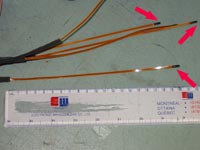MOSFET radiation monitoring system and Matroshka-R
Purpose
Most of the radiation that astronauts are exposed to in space comes from highly charged electrons and protons. The Canadian Space Agency (CSA) supported the development of a tool based on MOSFET (Metal Oxide Semiconductor Field Effect Transistor) dosimeter technology to measure this radiation.
Background
The MOSFET dosimeter is a miniature silicon device that measures radiation. When radiation hits the sensor, electrical charges are created, thereby changing the voltage of the device. Different kinds of radiation create different changes in voltage. Scientists calibrate the device on earth with various kinds of radiation to determine how much radiation is absorbed by the dosimeter in space.
MOSFET dosimeters have the advantage of being lighter and having thinner active areas than other radiation detectors. They can be used to estimate the amount of radiation received by the skin, eyes and Blood Forming Organs (BFO) by using shields of different thickness over the sensor.
The Canadian company Thomson and Nielsen Electronics Ltd. originally developed MOSFET dosimeters for radiation detection in the nuclear and medical fields. In 1991 the CSA commissioned Thomson & Nielsen to develop MOSFET detectors for space use, and in 1992 they were used for the first time in space aboard the Russian Bion-10 satellite. In 1995 the CSA requested Thomson & Nielsen to develop a prototype Astronaut Radiation Monitor (ARM) capable of measuring skin, eye and BFO radiation doses, as well as dose-rate. After initial tests aboard the Russian Bion-11 satellite in 1996, a monitor to measure astronauts' radiation exposures during a spacewalk, or extravehicular activity (EVA), was developed based on the ARM prototype. This monitor, called the ExtraVehicular Activity Radiation Monitor (EVARM), has been aboard the International Space Station (ISS) since 2001 and has produced valuable data on individual astronauts' skin, eye and BFO exposures during EVAs.

MOSFET dosimeter system: Reader with wires (top) connecting it to the sensors to be inserted inside the Matroshka-R phantom. (Credit: Thomson Nielsen)
Project description
Since Matroshka-R in 2002, the CSA began working with Thomson & Nielsen to develop a radiation monitoring device using MOSFET technology for a project called Matroshka-R. This project was led by the State Scientific Center of the Russian Federation Institute of Biomedical Problems (IBMP) of the Russian Academy of Sciences and was on the Russian segment of the ISS from 2005 to 2008. Matroshka-R estimated the amount of radiation received by the internal organs of humans in space by using a "phantom" - a spherical imitation of a human body made of material that imitates human tissues.
Along with a number of different detectors inserted in the phantom, including bubble detectors, the MOSFET detectors measured radiation doses to simulate internal organs. The MOSFET dosimeter system consisted of tiny silicon chip sensors mounted on flexible tape that were inserted into the phantom and an electronic data-reading device called a MOSFET reader.
The sensors continuously monitored voltage and recorded the radiation doses at regular intervals. MOSFET data from Matroshka-R was stored inside the MOSFET reader, and was downloaded to a computer.
The results of Matroshka-R indicated that the internal organs absorbed more neutron radiation than scientists expected. They hypothesize that cosmic rays were interacting with the phantom itself, creating a secondary source of neutrons. To gather more data, the CSA subsequently developed the follow-up experiment Radi-N, performed on board the Station in 2009.

Close up of MOSFET silicon chip sensors (shown by red arrows) mounted on flexible tapes inserted in the Matroshka-R phantom. (Credit: Thomson Nielsen)